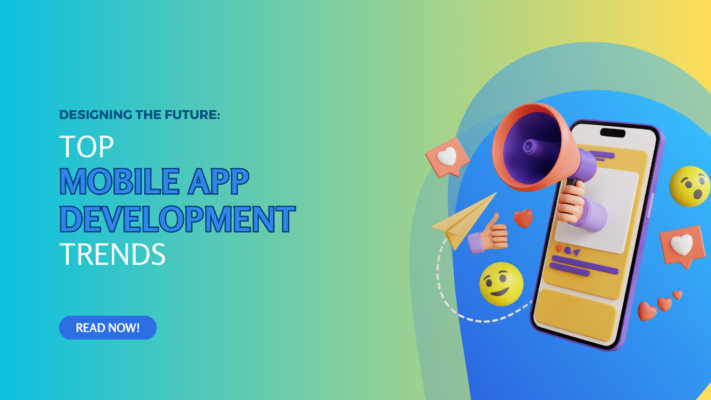
- March 8 2024
- admin
We live in a mobile-first world. As an avid smartphone user myself, I rely on apps for everything from ridesharing to grocery delivery, banking, entertainment, and more. Users like me expect smooth, intuitive app experiences with the latest innovations.
For developers, keeping pace with mobile’s rapid evolution is a must. The mobile app development trends shaping mobile app development today will drive user expectations tomorrow. In this post, I’ll share my insights on the top 10 mobile app development trends rising in 2024. By understanding what’s new and next in mobile, you can make savvy design decisions that delight users now and in the future.
Trend 1: AI Will Personalize Everything
Artificial intelligence is taking personalization to new heights. AI feeds users tailored content and features based on individual behaviors and preferences. For example, shopping apps recommend relevant products using the user’s purchase history data. Streaming apps suggest new shows based on past viewing.
As a user, I love when apps provide this hyper-personalized experience. It makes the app feel like it truly “gets” me. For developers, leveraging AI to make apps more intuitive and relevant should be a top mobile app development trend.
Trend 2: Augmented Reality Will Enhance Apps
Augmented reality (AR) overlays digital information onto the real world via a device’s camera. AR is moving beyond games into practical use cases like previewing furniture in your home before buying or getting repair instructions overlaid on your broken appliance.
Integrating AR experiences into apps adds an immersive, interactive dimension. As AR hardware improves, I expect AR apps to become a mass market. Developers should explore creative AR uses as a key mobile app development trend today.
Trend 3: Apps Will Work Across Devices
Users expect a seamless experience as we switch between smartphones, tablets, desktops, and more. Yet often, an activity started on one device won’t sync well on another.
Progressive web apps (PWAs) and new architectures allow apps to work consistently across platforms. Features like Handoff in iOS also enable better continuity. As a user, I want my workflow to feel unified no matter what device I’m on. Developers need to bridge the omnichannel gap as a mobile app development trend.
Trend 4: Instant Apps Provide Bite-Sized Experiences
Sometimes users just want a quick, focused app interaction without installing a whole new app. Instant apps allow specific app functionality without lengthy downloads. For example, you could quickly pay a merchant or view a coupon from within another app.
For light or one-off use cases, I prefer instant apps over installing yet another full-fledged app. Offering these hyper-focused mini-experiences meets user needs for speed and convenience as an emerging mobile app development trend.
Trend 5: Apps Embrace No-Code Development
Sophisticated no-code tools empower non-technical people to build mobile apps. With visual development and pre-built components, people can now create apps that previously required advanced coding skills.
Empowering no-code development means apps can meet more niche user needs. Students could design educational apps. Real estate agents could quickly build showing apps. No-code lowers barriers to innovation in the mobile app development trends.
Trend 6: “Lite” Apps Become Mainstream
Full-featured apps can be bloated, slow, and demanding on data and battery. Lite apps offer a streamlined experience using less memory, data, and battery power. Key functions stay intact while nonessential features get removed.
For users like me, lite apps provide better performance, especially on low-end devices or limited connections. They let me do what I need without the extra drain. Developers should consider “right-sizing” apps this way as a mobile app development trend.
Trend 7: Apps Embrace More Visual UI Design
Visual, and graphical interfaces are gaining prominence across mobile apps. Vibrant images, illustrations, and minimalist icons enhance engagement while reducing cognitive load. Interactive visuals also communicate better than text alone for many users.
Creative visual design makes apps more intuitive, instantly conveying value. As a mobile user, I’m much more drawn to apps with stimulating yet simple visual UI. This is a clear mobile app development trend to note.
Trend 8: App Security Becomes Critical
App security can no longer be an afterthought. Users won’t tolerate lax privacy or rampant data harvesting. Developing securely must be baked into the design process with encryption, access controls, and transparency.
I only feel comfortable using apps from developers I trust to safeguard my personal information. Make privacy and security top considerations in every development choice as a non-negotiable mobile app development trend.
Trend 9: App Stores Grow More Curated & Immediate
The top app stores are emphasizing curation and immediacy. App recommendations are more personalized while installs happen faster. App Clips in iOS allows part of an app to download instantly.
Curated app discovery helps users like me find apps that match my needs quickly. Frictionless installs let me use apps right away when needed. Catering to these user expectations can drive more downloads. App store optimization is a rising mobile app development trend.
Trend 10: Beacon Tech & Location Awareness Bridge Offline/Online
Beacon technologies like Apple’s iBeacon combine the physical and digital worlds. Apps can sense nearby beacons in stores to provide location-based services like self-checkout, promotions, or product finders.
With contextual awareness, apps become more helpful in navigating physical spaces. As a user, I appreciate when apps enhance my in-store experience with digital conveniences. Beacon tech makes that possible, as an emerging mobile app development trend.
Developing Cutting-Edge Mobile Apps
These 10 mobile app development trends give a glimpse into mobile’s exciting future. As devices get smarter and users more demanding, apps must continuously evolve. With creativity and skill, developers can architect the next-gen mobile experiences users crave.
Key mobile app development trends to keep top of mind include:
- Harnessing AI for personalized app experiences
- Incorporating immersive augmented reality
- Enabling seamless cross-device interactions
- Offering instant, hyper-focused mini-apps
- Embracing no-code tools for “citizen” development
- Streamlining apps through right-sized “lite” versions
- Using stimulating visual app design for engagement
- Making security and privacy core design principles
- Optimizing for app store curation and immediacy
- Connecting digital/physical with location-based beacon tech
By continuously innovating while protecting user needs, mobile developers can shape the future. The possibilities are endless if we design experiences that enhance people’s lives. That motivation keeps me passionate about creating the next generation of great apps. Let’s build the future together!
For organizations looking for an experienced partner to bring their app vision to life, Upcore Technologies is an ideal choice. With expertise across the latest mobile app development trends and technologies, Upcore develops cutting-edge iOS, Android, web, and multi-platform apps tailored to each client’s specific needs. Their focus on innovation, stunning design, and performance produces next-level user experiences. By partnering with Upcore, companies can confidently build the mobile apps of both today and tomorrow.


